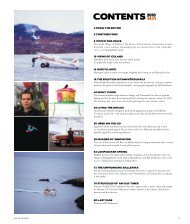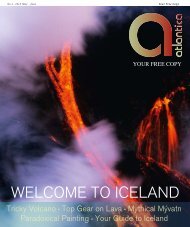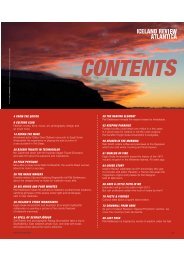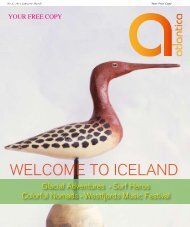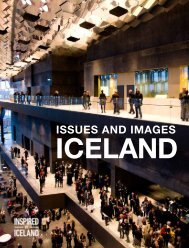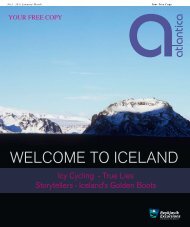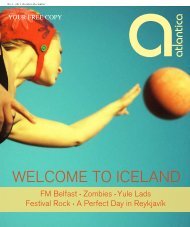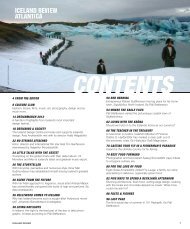Atlantica No. 4, 2010, July-August - Iceland Review
Atlantica No. 4, 2010, July-August - Iceland Review
Atlantica No. 4, 2010, July-August - Iceland Review
- No tags were found...
Create successful ePaper yourself
Turn your PDF publications into a flip-book with our unique Google optimized e-Paper software.
aicelandWorld Music in the Heart of TownNear the heart of Reykjavík, where Klapparstígur meets Grettisgata, you find a very unusual musical instrumentshop.World music is becoming increasingly popular as we are exposed to the musical heritage of different cultureslike never before. Sangitamiya – The Nectar Music is a musical instrument store that was establishedin response to this increasing interest in different musical traditions from all corners of the globe. The shophas an amazing variety of musical instruments and presentations of these instruments, as well as learningmaterial about them and the musical traditions to which they belong.The staff are musically trained and offer musical presentations and performances at schools for students ofdifferent ages and for various other occasions, which have been well received.At Sangitamiya all types and families of musical instruments are represented, including wind, string andpercussion instruments. It is well worth the visit. Grettisgata 7, sangitamiya.isFactsabout<strong>Iceland</strong>LAND: <strong>Iceland</strong> is an island of 103,000square kilometers (39,756 square miles) and4,970 kilometers of coastline, making it the16th largest island in the world. Only Madagascar,Britain and Cuba are larger single independentisland states. The country’s highestpeak, Hvannadalshnjúkur, rises 2,110 metersabove sea level. Roughly ten percent of thecountry is covered in glaciers, including Vatnajökull,the largest in Europe. But get herequick before the glaciers melt: Sólheimajökull,an outlet glacier of the Mýrdalsjökull ice cap,south <strong>Iceland</strong>, is presently retreating at a rateof approximately 100 meters per year.ENERGY: Because of its location on theMid-Atlantic Ridge, <strong>Iceland</strong> is a hotbed ofvolcanic and geothermal activity: thirty volcanoeshave erupted in the past two centuries.Natural hot water supplies the majority ofthe population with inexpensive, pollutionfreeheating.PEOPLE: <strong>Iceland</strong>’s population is about313,000, about six percent of which are foreignborn.It’s growing at a rate of 2.6 percent peryear. Only 2 percent of <strong>Iceland</strong>ers live in ruralareas, the rest live in urban areas, and the majority,about 75 percent, live in the capital area ofReykjavík. But <strong>Iceland</strong>’s population more thandoubles every year thanks to the more than500,000 travelers who visit the country annually.TIME: Despite its mid-Atlantic location,<strong>Iceland</strong> observes Greenwich Mean Time yearround.HISTORY: It is believed that the first permanentsettler in <strong>Iceland</strong> was Ingólfur Arnarson, a<strong>No</strong>rwegian Viking who settled in A.D. 874 andnamed his home Reykjavík (smoky bay) afterthe steam rising from the surrounding countryside.In 930, <strong>Iceland</strong>ers founded Althingi, whichstill functions as the legislative body, making itthe world’s oldest parliament. In 1262, <strong>Iceland</strong>lost its independence to <strong>No</strong>rway and in 1380came under Danish control with <strong>No</strong>rway. On17 June 1944, <strong>Iceland</strong> became independent ofDenmark in a ceremony that took place atThingvellir, the old site of Althingi, now aUNESCO World Heritage Site.GOVERNMENT: The country is governed byAlthingi (parliament), which sits in Reykjavík,whose members are elected every four years.The President is also elected every four years,but the Prime Minister is primarily responsiblefor the day-to-day politics. Jóhanna Sigurdardóttiris <strong>Iceland</strong>’s current PM (2009) and ÓlafurRagnar Grímsson (1996) is serving his third termas president.LANGUAGE: <strong>Iceland</strong>ers are of <strong>No</strong>rse and Celticancestry, and have lived for more than a millenniumfar away from other countries, which hasprovided geneticists with a key body of DNA. Thelanguage, <strong>Iceland</strong>ic, is close to that of literature(the Sagas) in the 12th century. Most people canalso speak English. <strong>Iceland</strong>ers maintain a patronymicnaming system, which means that someone’sfirst name is followed by his or her father’sname and the suffix ‘son’ or ‘dóttir’. For example,Kolbrún Pálsdóttir is Kolbrún, the daughter ofPáll.CHURCH: Church and state are not separatedin <strong>Iceland</strong>. The National Church of <strong>Iceland</strong>, aLutheran body, is the state church to which 82 percentof <strong>Iceland</strong>ers belong. There is, however, oneRoman Catholic cathedral in Reykjavík to servethe just over 2 percent Catholic population.ECONOMY: <strong>Iceland</strong>’s GDP per capita is USD45,000. Aside from fishing and fisheries products,the country’s other main export is aluminum,while primary imports include machinery andequipment, petroleum products, and food andtextiles. Less than one percent of the land is arable(most is used for grazing) and between one andtwo percent of <strong>Iceland</strong>’s population is engagedin agriculture. <strong>Iceland</strong> produces vegetables, meat,fish and dairy, but imports other foodstuffs. <strong>Iceland</strong>’scurrency is the <strong>Iceland</strong>ic Króna (ISK).HEALTH: Life expectancy for women is 83.0years and 79.4 for men, one of the highest in theworld. a80 atlantica



